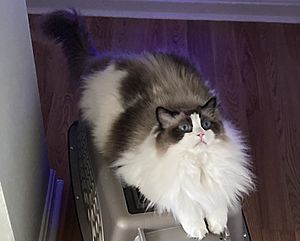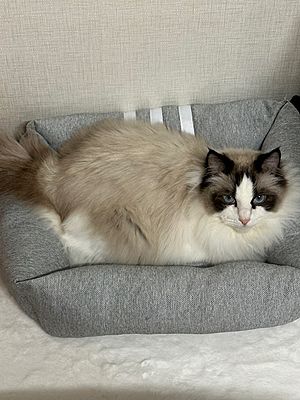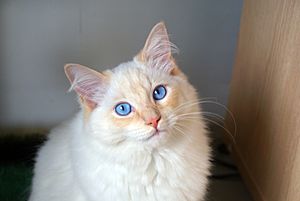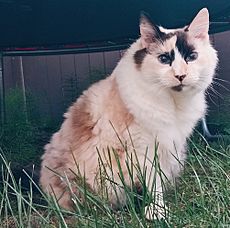Ragdoll facts for kids
Quick facts for kids Ragdoll |
|
|---|---|

Ragdoll cat
|
|
| Origin | California, United States |
| Breed standards | |
| CFA | standard |
| TICA | standard |
| Domestic cat (Felis catus) | |
The Ragdoll is a special type of cat known for its unique look. They have a specific color pattern on their fur and beautiful blue eyes. Ragdolls are large and have soft, silky coats.
An American breeder named Ann Baker created this breed in the 1960s. Ragdolls are famous for being very calm, gentle, and loving. They got their name because they tend to go limp and relaxed when you pick them up, just like a ragdoll toy. These cats are very popular in places like the United Kingdom and the United States.
People often call Ragdolls "dog-like cats" or "puppy-like cats." This is because they often follow their owners around the house. They also enjoy being held and are usually friendly with other pets.
You can spot a Ragdoll by its pointed colors, where the face, ears, legs, and tail are darker than the rest of the body. They have big, round blue eyes and thick, soft fur. Their bodies are soft, and they have long, bushy tails. Their fur colors are often a mix of three or two colors.
Contents
History of the Ragdoll Cat
The Ragdoll breed started in Riverside, California. A breeder named Ann Baker developed them. She had a regular, long-haired white cat named Josephine. Josephine was not a special breed herself.
Josephine later had kittens that were very calm and loving. These kittens also had the special trait of going limp when picked up. This was different from her earlier litters.
From these first special kittens came two important cats. One was Blackie, an all-black male. The other was Daddy Warbucks, who had a seal point color with white feet. Daddy Warbucks became the father of Fugianna, a bi-color female. Blackie was the father of Buckwheat, a dark brown female. Both Fugianna and Buckwheat were Josephine's daughters. All Ragdoll cats today are related to these early cats from Ann Baker.
Ann Baker did something unusual for cat breeding. She made the name Ragdoll a special trademark. Around 1971, she started her own group called the International Ragdoll Cat Association (IRCA). She made strict rules for anyone who wanted to breed or sell cats using the Ragdoll name. Other cat groups were not allowed to register Ragdolls. The IRCA still exists but is much smaller, especially after Ann Baker passed away in 1997.
In 1975, a couple named Denny and Laura Dayton decided to work differently from the IRCA. They wanted the Ragdoll breed to be recognized by bigger cat organizations. They started with two IRCA cats and helped create the Ragdoll standards we know today. Major cat groups like the CFA now accept these standards. Around the 1960s, some Ragdolls were also sent to the UK. More cats followed, helping the breed become well-known in the UK. The Governing Council of the Cat Fancy in the UK recognizes them.
What Makes Ragdolls Special?
Ragdoll Cat Temperament
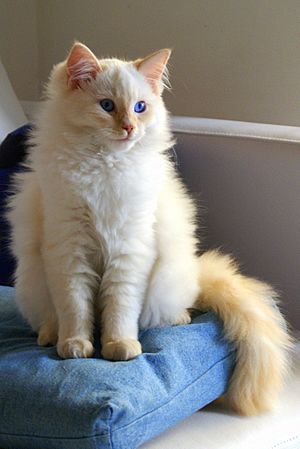
Ragdolls are known for being very calm and "floppy." Some people think this calm nature comes from their ancestors, like Persian and Birman cats. It might also be how they naturally react when picked up.
Some people used to believe that Ragdolls couldn't feel pain because they were so relaxed. This is a myth and not true. Some breeders in Britain have even tried to make them less limp. They worry that being too relaxed might not be good for the cat's health.
Ragdolls are often described as loving, smart, and easy-going. They are known as great lap cats. They are called "puppy cats" or "dog-like cats" because they are so friendly. They often follow their owners from room to room. They also love getting attention, much like some dog breeds.
Ragdolls can learn to fetch toys and enjoy playing. They stay playful even when they get older. Unlike many other cat breeds, Ragdolls usually prefer to stay on the ground. They don't often try to climb to the highest spots in your home.
Ragdoll Cat Physical Traits
The Ragdoll is one of the biggest domesticated cat breeds. Female Ragdolls usually weigh between 8 to 15 pounds (3.6 to 6.8 kg). Males are much bigger, weighing 12 to 20 pounds (5.4 to 9.1 kg) or even more. It can take up to four years for a Ragdoll to grow to its full size.
They have strong bodies and a bulky build. Their legs are well-proportioned. Their heads are wide with a flat top and wide space between their ears. They have long, muscular bodies with broad chests and short necks. Their tails are bushy and long. Their paws are large, round, and have tufts of fur. Their coats are silky, thick, and medium to long in length. Because their fur is long, you should brush them at least twice a week. Adult Ragdolls grow fluffy fur on their back legs and a ruff (a collar of fur) around their necks.
The breed is famous for its large, round, deep blue eyes. The genes that give them their pointed fur also give them these special blue eyes. Cats with more intense shades of blue eyes are often preferred in cat shows.
Even though Ragdolls have a plush coat, it mostly has long guard hairs. They don't have a very thick undercoat. This means they shed less and their fur is less likely to get tangled, according to the Cat Fanciers' Association. However, you might notice more shedding in the spring.
Ragdolls come in six main colors: seal, chocolate, and red. They also come in lighter versions of these colors: blue, lilac, and cream. You can also find them with lynx and tortoiseshell patterns in all these colors. Ragdoll kittens are born white. Their true colors start to show at 8–10 weeks old. They reach their full color and coat at 3–4 years of age.
Ragdoll Fur Patterns
- Colorpoint – This pattern means one color gets darker on the cat's face, ears, tail, and paws.
- Mitted – This is like the colorpoint pattern, but the cat also has white paws and a white belly. They might have a white line or spot on their face (called a blaze). They must have a white stripe from their chin to their back legs and a white chin. Mitted Ragdolls were not allowed in CFA shows until 2008. People sometimes confuse them with Birmans. You can tell them apart by size (Ragdolls are bigger) and chin color (Mitted Ragdolls have white chins, Birmans have colored chins). Breeders also look at head shape and bone structure.
- Bicolor – These cats have white legs and a white inverted "V" shape on their face. They also have a white belly and sometimes white patches on their back. If a bicolor cat has too much white, it's called a Van pattern, but this is not as common.
Ragdoll Fur Variations
- Lynx – This is a type of colorpoint cat with tabby markings (stripes). This variation always has white lines around the ears, no matter the pattern.
- Tortoiseshell or "tortie" – This variation has mottled or mixed colored markings within the patterns mentioned above. Even with a lot of white fur, tortie points are not calico cats. The calico gene is different and not found in colorpoint cats.
Ragdoll Cat Health
A study using information from Sweden showed that among common cat breeds, Ragdolls and Siamese cats have a lower survival rate. Ragdolls usually live for 12 to 15 years.
Heart Health: Hypertrophic Cardiomyopathy
Hypertrophic cardiomyopathy (HCM) is a common heart disease in all cats. It is often caused by genes. This disease makes the walls of the heart thicker. This means the heart cannot pump blood as well as it should. Sometimes, it can lead to sudden death.
In Ragdolls that have two copies of the HCM gene, the problem can appear early. This might be as young as six months old. It tends to be serious, and most of these cats may pass away by age 3. Cats with only one copy of the HCM gene usually get the disease later. It also progresses more slowly and has less serious effects.
A DNA test was created in 2007 to find the gene that causes HCM in Ragdolls. If breeders only use Ragdolls that do not have this gene, their kittens will not develop this specific type of HCM.
Studies in 2013 found that the HCM gene (R820W mutation) was present in about 17% of Ragdolls in Italy and 23% in the US. Another reference states that about 30% of Ragdolls in the UK have this gene. The overall rate of HCM found in one study was about 2.9%.
See also
 In Spanish: Ragdoll para niños
In Spanish: Ragdoll para niños


